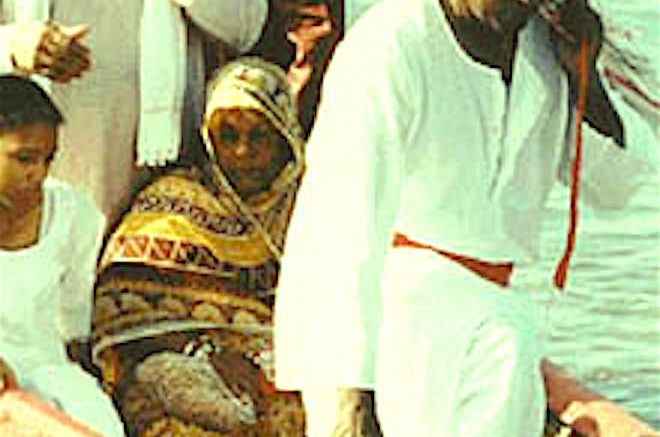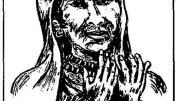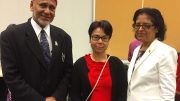From 1845 to 1921, over 36,000 East Indians, mainly of the Hindu faith, were brought to Jamaica. Close to two-thirds of them remained. Following the abolition of slavery in the1830s, after failed attempts to source much-needed labour through bountied European immigration, the Jamaican Government turned to India and China. Indian labourers who had already proved successful in Mauritius, were therefore considered to be a good bet for survival in Jamaica.
They were, however, paid less than the ex-slaves and therefore originally lodged at the bottom of the society. Ironically, under the terms of their caste system, which valued light skin over dark, they in turn looked down on the ex-slaves. Relations between the two groups did not therefore begin on the best of footings.
The Indian Government took great interest in indentured labour. Recruiting depots were established in Calcutta and Madras and agents were paid significantly less, per recruit, than for a European labourer). The Government monitored recruitment, the terms and conditions of indentureship, and the guidelines for transport to Jamaica as well as eventual repatriation to India. Most Indians who signed onto indentureship did so with the hope of returning to their homelands with greater wealth and therefore better social positions. It even appointed a Protector of Immigrants in the country of indenture.
Unfortunately, as the Protector was never an Indian national, he tended to be more interested in the welfare of the employers than the labourers a sign that the programme would equal one of hardship for the labourers.
In order to sign onto an indentureship Indians were to appear before a magistrate, hold a government permit and fully understand the conditions of the labour contract. However, the contract was often explained in English and thousands of labourers simply put their thumb marks on the required line, without any true understanding of what awaited them following their journey across the sea.
ARRIVAL IN JAMAICA
In 1845 the first group landed at Old Harbour Bay. They came from Northern India, 200 men, 28 women under 30 years old and 33 children under 12 years old, 261 people in all. The next year, five times more arrived, 1, 852 the following year, almost double that number, 2,439. At that point, the Indian Government stopped immigration in order to examine the way the system was working. The programme began again 11 years later in 1859 and continued without break until it was interrupted by World War I even though by the 1870s the Indian government began to regard the practice with disgust as stories of the hardship encountered by Indians on arrival in the West Indies began to circulate.

East Indians preparing rice, Jamaica [circa 1890].(Image from the National Library of Jamaica)
On arrival, the labourers were given one suit of clothing, agricultural tools and cooking utensils. Divided into groups of 20 and 40 they were then sent first by mule cart and later by overcrowded freight trains to plantations in Portland, St. Thomas, St. Mary, Clarendon and Westmoreland. Many were forced to walk to the plantation from the nearest railway station. Once on the plantation itself, they were forced to work five to six days a week for one shilling a day and lived in squalid conditions. Barracks of no more than 3 or 4 rooms were expected to accommodate several individuals and families in each room. Two shillings and six pence were deducted weekly for their rice, flour, dried fish or goat, peas and seasoning rations. Children received half rations and employers were warned to treat the children well. For example, they were supposed to receive quarterly medical check ups.
During the 70 years of Indian immigrant labour, little consideration was shown for their religious beliefs and cultural practices. For example, non-Christian unions went unrecognized until 1956 and many were therefore forced to accept Christianity. The terms of indenture could be as short as one year and as long as five, with two weeks annual leave. Labourers could be released from their indenture due to illness, physical disability or in the rare case, manumission or commutation, when the labourer paid the unexpired portion of the contract to their employer. They could only leave the plantation, however, if in possession of a permit. If caught without one or if they failed to work because of ill health or any other reason, they often faced fines and even imprisonment. Many suffered greatly from yaws, hookworm and other tropical diseases such as malaria. Although available, quinine, able to prevent malaria, was not often provided by the planters.
When their indentureships were up, they became known as time-expired Indians and issued certificates of freedom that enabled them free access to any part of the island. Two years later and no earlier, they could apply for repatriation. If they did not do so they became ineligible even though they could only be repatriated after having lived in Jamaica for 10 years. Of course, there was always the other option to renew their contracts and become “second-term coolies”. Few made this choice.
SETTLEMENT AND REPATRIATION
Most of the planters were against repatriation as the costs of sending the immigrants home were thought to exceed any advantage gained from having them in Jamaica. They effectively lobbied the Government to provide incentives for settlement and to limit their required contribution to repatriation costs. In the early years of Indian immigration, land and money were used as the main incentives. Time-expired Indians could accept 10 or 12 acres of Crown land. Often the land offered was mountainous and infertile so many chose to take the cash in hand. By 1877 close to £32,000 had been spent on these money grants.
In 1879, however, money grants were suspended so all who decided not to take up the land grants were forced to find land on their own. The land grants themselves were suspended briefly from 1897 to 1903 and then finally abandoned in 1906. The land grant system was proving to be as expensive as repatriation themselves with land grants costing £12 per person and repatriation costing some £15 per person.
In addition, the number seeking repatriation did not diminish drama-tically even though after 1899 male immigrants seeking repatriation were obliged to pay up to one-half of their passage and female immigrants up to one-third. Immigrants were further required to pay for blankets and warm clothing.
PROBLEMS IN RETURNING
Other factors that led to greater numbers of time-expired Indians settling in Jamaica included the fact that Jamaica failed to regularly provide ships for repatriation one reason stated was that the ship needed to be full to sail and full passage was not always guaranteed given the number of stipulations to which the immigrants had to adhere. Other times, the ships were overfull and some, most often the healthiest, were forced stay behind. Preference tended to be given to the old and infirm. Occasionally disabled or invalid immigrants seeking return passage were denied and forced to remain in Jamaica where they became charges of the immigration fund of the parochial treasury. After 1914, World War I also disrupted ocean travel as ships were needed for war service.

A group of East Indians re-enact their arrival to Jamaica, stepping onto new ground at Old Harbour Bay, where they first landed in May 1845.
In addition, the Indian Government was not very happy about reclaiming these immigrants because often they returned destitute, had high mortality rates and suffered significant re-adjustment problems as they were in essence strangers in the land of their birth.
The last set of Indian indentured immigrants arrived in Jamaica in 1914 and the last repatriates left in 1929 with legal repatriation ending in 1930. After 70 years 53 per cent of Indians who arrived in Jamaica between 1845 and 1916 remained. They survived by sticking closely together, building on bonds forged during their journeys where ship brothers and sisters were created, and sharing in religious and cultural practices. In the 1880s many left Jamaica to work on the Panama railroad and canal in the 1880s to return at a later date. On the plantations when their required work was over the Indians often tended their own gardens and filled their evenings with storytelling, singing, ganja smoking and drinking. In fact it was the Indians who introduced ganja and the chillum pipe, called a chilam in India, to Jamaica. They held regular weekend prayer meetings and special ceremonies to commemorate weddings, Hindu festivals such as Diwali (the festival of lights) and Islamic festivals of Hosay and Eid. Others left the plantations for Kingston and took jobs that used skills they brought with them and others they acquired. They began to learn English and became jewellers, fishermen, barbers, shopkeepers. Regardless of whether they lived in the city or the country, many worked hard to maintain their cultural traditions as best as they could even though out of a need for economic survival and social acceptance many became Christians.
JAMAICAN INDIANS
Indian contributions to Jamaican culture are legion. Indian jewellery designs have made their mark especially in the form of intricately wrought thin, gold bangles. The tradition goes back to the 1860s when plantation workers began to create these pieces and organized traveling salesmen to peddle them island-wide. It was the Indians who first managed to grow rice in Jamaica, establishing the island’s first successful rice mill in the 1890s. They also dominated the island’s vegetable production until well into the 1940s.

Jamaica Hosay Parade
Old animosities forgotten, elements of traditional Indian dress can be found in Jonkonnu processions and many African-Jamaicans participate alongside their Indian-Jamaican brothers and sisters in the Indian inspired cultural celebrations of Hosay and Divali. Hosay is a muslim festival that re-enacts a war between Mohammed’s sons, their death and burial. It lasts for 9 nights and on the tenth day the tazia (a paper and bamboo replica of a tomb) is taken to the streets in a large, colourful procession led by a Tasa drummer and followed by stick and horse dancers.
In the past, every plantation in each parish celebrated Hosay. Today it has been called an Indian carnival and is perhaps most well known in Clarendon where it is celebrated each August. Divali, a Hindu festival linked with the reaping of grain, the return of Prince Rama after 14 years in exile, and the victory of good over evil, is celebrated late October to early November on the darkest night of the year. Houses are cleaned and brightly lit and everyone is in high spirits.
Today there is an estimated number of close to 70,000 Indians living in Jamaica. They maintain their own cultural organizations, aspiring to keep links to their roots whilst still managing to assimilate into the national scene. This is perhaps well illustrated by the fact that traditional Indian foods such as curry goat, roti and callaloo have become part of the national cuisine. Caste is not a significant issue and arranged marriages are no longer common. Descendants of the immigrant workers have influenced the fields of farming, medicine, politics and even horse-racing. Names such as Chatani, Chulani, Tewani, Mahtani, Daswani, Vaswani and Chandiram have become synonymous with manufacturing, wholesale, retail and in-bond businesses providing employment for thousands of Jamaicans.
Sources: Mansingh, L. and A. “The Indian tradition lives on” in A tapestry of Jamaica The best of Skywritings, Air Jamaica’s in-flight magazine. Kingston: Creative Communications Ltd. and Oxford: Macmillan Publishers. p. 364-366, Mansingh, L. and A. Indian heritage in Jamaica in The Jamaica Journal, 10, (2,3,4), 10-19, Parboosingh, I.S. An Indo-Jamaica beginning in The Jamaica Journal, 18, (3), 2-10, 12, Sherlock, P. and Bennett, H. (1998). The story of the Jamaican people. Kingston: Ian Randle Publishers, Shepherd, V. Transients to citizens The development of a settled East Indian Community in The Jamaica Journal, 18, (3), 17-26.





This is very helpful in learning about the India culture. I am grateful.